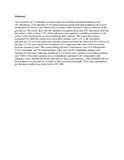The dissipation of malathion and dimethoate from the pea plants (Pisum sativum) under controlled conditions

View/
Date
2000Author
Getenga, ZM
Jondiko, JIO
Wandiga, SO
Beck, E
Type
ArticleLanguage
enMetadata
Show full item recordAbstract
14C‐malathion, [S‐1,2‐bis(ethoxycarbonyl)ethyl O,O‐dimethyl phosphorodithioate] and 14C‐dimethoate, [O,O‐dimethyl S‐(N‐methylcarbamoylmethyl)phosphorodithioate] have been administered to leaves of pea (Pisum sativum) plants under simulated tropical conditions in the greenhouse. The results show that l4C‐malathion dissipated faster than 14C‐dimethoate from the leaf surface: After 16 days, 5.7% of the radioactive dose applied as malathion remained on the surface of the treated leaves as surface (dislodgeable) residues. The extractable residues constituted 9% while the bound (non‐extractable) residues were 4.2% of the total initial radioactivity. 16.7% of the initial dose had been translocated from the treated leaves to the rest of the plant. 17.1% of the initial dose constituted 14C‐compounds other than 14CO2 recovered from the transpired water. The corresponding fractions of dimethoate were 21% dislodgeable, 17.4% extractable, and 5% bound residues. Only 4.6% of 14C‐dimethoate residues were distributed in the plant. Although dimethoate is 170 times more soluble in water than malathion, only 10.4% of the initial pesticide dose of dimethoate constituted 14C‐compounds in the transpired water. Dimethoate formed dimethoxon, the oxygen analogue, while malathion did not form malaoxon in the plant, as revealed by thin layer chromatography (TLC) and confirmed by gas chromato‐graphy‐mass spectrometry (GC‐MS).
URI
http://www.tandfonline.com/doi/abs/10.1080/02772240009358952#.Ubs2QWeoNkhhttp://erepository.uonbi.ac.ke:8080/xmlui/handle/123456789/34144
Citation
The dissipation of malathion and dimethoate from the pea plants (Pisum sativum) under controlled conditions Z.M. Getenga, J.I.O. Jondiko, S.O. Wandiga, E. Beck Toxicological & Environmental Chemistry Vol. 77, Iss. 3-4, 2000Publisher
University of Nairobi Department of Chemistry, University of Nairobi Department of Chemistry, Maseno University
